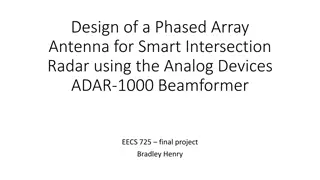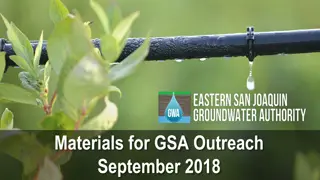Overview of GSA Antenna Outleasing Program
"Explore the legislative history, definition, and guidelines of the GSA Antenna Outleasing program, covering authorities applicable to antenna outleasing and negotiated terms for antenna site usage. Learn how federal agencies can facilitate access to rooftops for private sector carriers to enhance mobile services."
Download Presentation

Please find below an Image/Link to download the presentation.
The content on the website is provided AS IS for your information and personal use only. It may not be sold, licensed, or shared on other websites without obtaining consent from the author. Download presentation by click this link. If you encounter any issues during the download, it is possible that the publisher has removed the file from their server.
E N D
Presentation Transcript
Outleasing Rooftop Antennas US General Services Administration PBS, Office of Portfolio Management and Customer Engagement, National Outlease Program
Todays Objectives: Overview of legislative history Rooftop antenna outleasing definition Authorities applicable to rooftop antennas Antenna Outlease Guidelines GSA Antenna Outlease Process Summary
Legislative History Presidential Memorandum 8/10/95 Facilitating Access to Federal Property for the Siting of Mobile Services Directed Federal agencies to open rooftop access to private sector carriers wanting to expand their network The Telecommunications Act of 1996 (47 USC 332) Promoted competition, shared resources, etc. GSA Bulletin FMR 2007-B2 Provided Federal agencies with general guidelines, processes for implementing the Presidential Memorandum and the Telecommunications Act The FMR guidance was followed by Federal Register 102-79.75 11/23/2024 GSA Antenna Outlease Training 3
What is Outleasing? GSA defines outleasing as the temporary disposal of vacant or underutilized government owned or leased space by leasing to: Private sector State or local government entities 11/23/2024 GSA Antenna Outlease Training 4
Authorities Applicable to Antenna Outleasing Cooperative Use Act 40 USC 581(h) (Can be delegated to other agencies) Can charge local commercial (i.e., market based) rates Limited to certain types of activities Commercial, cultural, educational and recreational Limited to certain areas of public buildings (e.g., pedestrian access levels, court- yards and rooftops) Adaptive Use Authority under Section 111 of the NHPA 54 U.S.C. 306121 and 306122 Broad authority to outlease unused portions of historic properties Allows proceeds to be retained and used to maintain the property Proceeds can only be used on property generating the outlease revenue or other properties listed in the National Register. Section 704 of Telecommunications Act and P.L. 112-96 Sec. 6409 for Easements, Right-Of-Way 11/23/2024 GSA Antenna Outlease Training 5
Antenna Outlease Guidelines Use Fees for antenna site and shelter (if needed) are based on commercial rates identified by market survey In areas too rural for market survey, BLM Antenna Pricing Index is a resource Easements/RoW fees are based on direct cost recovery If easement/RoW unimproved land, consult with agency Environment Preservation Officer (EPO) Use Fees, Terms and Conditions are negotiated in the best interest of the Federal government 11/23/2024 GSA Antenna Outlease Training 6
Antenna Outlease Guidelines FCC, Radio Frequency Interference (RFI) and International Building Code (IBC) Requirements Must provide a copy of current FCC license which must specify the expiration date. No outlease contract will be let for a company with an expired FCC license. At its own expense, obtain written certification, commonly known as a Radio Frequency Interference (RFI) Certification Report Reviewed by Building Engineer Must use counter weights that are securely connected on ballast that conform to IBC wind requirements. (IBC Section 1609) 11/23/2024 GSA Antenna Outlease Training 7
Antenna Outlease Guidelines Additional Square Footage Charges, Signage and Height Restriction Enforcement Rooftop space to house the supporting electronics cabinet subject to a negotiated rate, may be blended with the antenna rate. Carrier required to provide/post signage to protect workers, public from microwave exposure. Adherence to local zoning regulations for area height restrictions strictly enforced. 11/23/2024 GSA Antenna Outlease Training 8
Antenna Outlease Guidelines Antenna Installation on Historic Building Rooftops Antenna installations on buildings on the National Register or eligible to be on the National Register must meet Section 106 requirements of NHPA. Agency Historic Preservation Officer involvement required to insure no impact 11/23/2024 GSA Antenna Outlease Training 9
Antenna Outlease Guidelines Subleasing and Co-locating The option of subleasing is permissible Co-location with other telecommunication providers is allowed RFI certification must show no interference, or if frequency interference, RFI must be remedied for installation to proceed GSA will issue a separate outlease for each company co-locating on an installation. 11/23/2024 GSA Antenna Outlease Training 10
Antenna Outlease Guidelines Change of ownership or bankruptcy The telecommunications industry is very volatile, with companies frequently sold and acquired. Be aware that sometimes when rent becomes delinquent for an antenna contract, the original client may have changed ownership without notifying GSA. If a company notifies GSA that a change in ownership has taken place, immediate action is required to either: Negotiate new contract with the new telecommunication company or Amend existing contract to change the ownership name The preferred choice as the contracts are multi-year. The original client must provide, in writing to GSA, the name change information and the effective date. Bankruptcies are not unknown. Although language should be in the antenna outlease contract requiring notification of changes in ownership, vigilance is required. Bankruptcies require Legal counsel involvement and can take a year or more to resolve 11/23/2024 GSA Antenna Outlease Training 11
Antenna Outlease Guidelines SITE RESTORATION Contract should contain specific direction that, upon termination or expiration of the contract, all telecommunication equipment and supporting equipment must be removed at carriers expense. Do not skip the final site inspection. Abandoned equipment results in a removal cost for the Government. 11/23/2024 GSA Antenna Outlease Training 12
Antenna Outlease Guidelines The following are requirements to follow when outleasing antenna space on a rooftop with a solar project: Photovoltaic (PV) Roof Membranes PV roof membrane is a roof covering where the wafer-like solar collection panels sit flat upon the surface of the roofing material; typically does not cover entire roof surface. Nothing can sit on top of the membrane. The membrane cannot be penetrated. Staff/Contractors/Technicians may not walk upon the membrane. Nothing may cast shade of any amount for any length of time onto the collection surface. Even a shadow the width of a guy line can shut down the entire collection grid. While PV membrane creates an electromagnetic field, it is very low grade and of a different voltage from radio microwave antennas, and hence the one does not interfere with the other. 11/23/2024 GSA Antenna Outlease Training 13
Antenna Outlease Guidelines Solar Projects, cont d: SOLAR ROOFTOP PANEL ARRAYS These solar collectors are panels mounted on stands oftentimes arranged in an array on the rooftop. Typically they do not cover the entire rooftop surface in order to allow for fire fighter access and equipment maintenance. Nothing may cast shade of any amount for any length of time onto the collection surface. Even a shadow the width of a flagpole can shut down the entire collection grid. While it is true solar panels create an electromagnetic field, it is very low grade and of a different voltage from radio microwave antennas, and hence the one does not interfere with the other. 11/23/2024 GSA Antenna Outlease Training 14
Antenna Outlease Guidelines Solar Projects, cont d: ANOTHERROOFTOPSOLARCOLLECTORCONSIDERATION Although unlikely, it is worth noting that radio frequency issues may occur when a solar field is installed where antennas are already present. If an antenna broadcasts across the solar field it may cause an increase in radio frequency creating a potentially dangerous exposure for anyone on the roof. A radio frequency inspection can determine whether the placement of the antenna relative to the solar collectors will create a radio frequency disruption. 11/23/2024 GSA Antenna Outlease Training 15
GSA Outlease Process Summary THE PROCESS Begins with a phone call or email from a telecommunications carrier representative CO/COR sends application form Wireless Telecommunication Industry Application, Form GSA3729-15 available at https://www.gsa.gov/portal/content/191703 Initial project team: CO, COR, Property Mgt, Asset Mgt, RHPO/EPO Initial Site Survey Initial Project Sketch from Carrier Property Mgt/RHPO/EPO location agreement If asset historic, obtain NHPA compliance certification. If undeveloped land, obtain NEPA compliance certification 11/23/2024 GSA Antenna Outlease Training 16
GSA Outlease Process Summary THE PROCESS, CONT D Contract negotiations begin, Carrier develops Installation Plans Plans received, submitted to building engineering and fire and life safety Approvals obtained, CO proceeds to lease/license execution Onsite preconstruction meeting with Property Mgt Carrier installation build out begins Inspections, access coordination, enforcement Final walkthrough with Property Mgt Contract Administration Begins 11/23/2024 GSA Antenna Outlease Training 17
Contacts and Forms Wireless Telecommunication Company Application and Master Antenna Forms available at www.gsa.gov GSA CO Contact: Mary Ann Hillier National Outlease Program Manager 202-208-6139 maryann.hillier@gsa.gov 11/23/2024 GSA Antenna Outlease Training 18

























